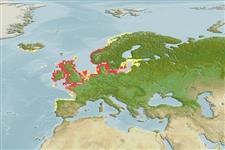Actinopterygii (ray-finned fishes) >
Perciformes (Perch-likes) >
Ammodytidae (Sand lances)
Etymology: Hyperoplus: Greek, hyperoplos = that has vanity with its weapons (Ref. 45335).
Environment / Climate / Range
Ecology
Marine; brackish; demersal; oceanodromous (Ref. 51243); depth range 6 - 30 m (Ref. 57178). Temperate, preferred ?; 80°N - 37°N, 25°W - 36°E
Northeast Atlantic: Murman and Spitzbergen to Portugal, including Iceland and much of the Baltic.
Length at first maturity / Size / Weight / Age
Maturity: Lm ?, range 11 - 15 cm
Max length : 40.0 cm SL male/unsexed; (Ref. 4674); common length : 20.0 cm TL male/unsexed; (Ref. 4645)
Short description
Morphology | Morphometrics
Tip of pectoral fin reaches the front end of the dorsal fin. Dark spot on each side of the snout. Two pointed teeth in the palate. Upper jaw not protractile (Ref. 35388).
Inshore, including the inter-tidal zone and estuaries, and offshore to about 60 m depth. Commonly associated with Ammodytes species. Feeds initially on zooplankton, later small fish (clupeids and ammodytids) dominate the diet. Summer batch spawner. Used mainly for fishmeal and oil, but also utilized fresh and pan-fried for human consumption (Ref. 9988).
Muus, B.J. and P. Dahlström, 1974. Collins guide to the sea fishes of Britain and North-Western Europe. Collins, London, UK. 244 p. (Ref. 173)
IUCN Red List Status (Ref. 115185)
CITES (Ref. 94142)
Not Evaluated
Threat to humans
Harmless
Human uses
Fisheries: highly commercial; bait: occasionally
More information
ReferencesAquacultureAquaculture profileStrainsGeneticsAllele frequenciesHeritabilityDiseasesProcessingMass conversion
Tools
Special reports
Download XML
Internet sources
